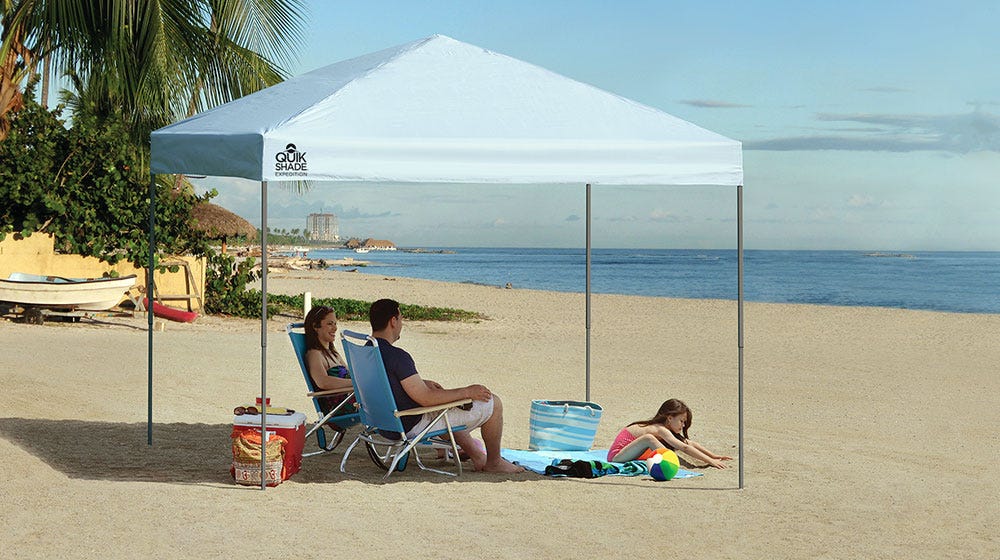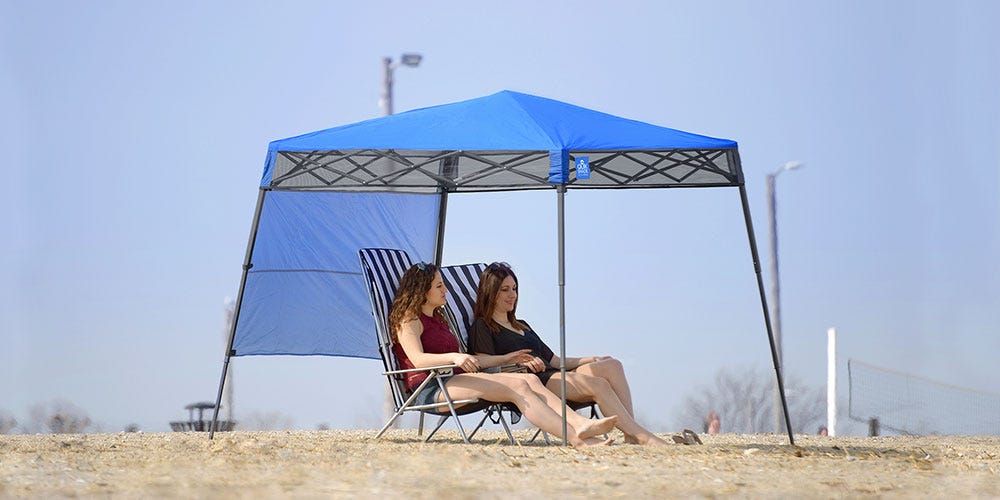Having a tailgate tent or a pop-up canopy may make all the difference when going to the beach or hosting a backyard BBQ. A canopy tent for the beach will help safeguard your family and friends from the sun and also ensure that everyone has a good time.
A pop-up canopy, shade or tent will give you with sun, rain, or wind protection and may be utilized in nearly any environment. They're incredibly adaptable because they are available in a number of sizes and designs. The size and style of canopy you utilize will be determined by the type of event you're hosting and the amount of people you select to shade.
When selecting a pop-up canopy tent for the beach, make sure it is lightweight, small, and simple to put together in a matter of minutes. When selecting a pop up canopy, consider the weight and longevity of the structure.
What is a Pop-Up Canopy Tent?
A pop-up canopy (also known as a movable pavilion or framed tent in certain countries) is a temporary shelter. Canopies of this sort often range in size from 5 ft x 5 ft feet to 10 ft x 20 ft. Marquees are larger or semi-permanent canopies.
Canopy tents are frequently used for summer barbeques and vendor fair events. They'll be at family reunions, graduation celebrations, and beach parties, among other places. Canopy tents vary from ordinary tents in that they lack sides.
Pop-up canopies seem to be the most convenient alternative. Many are especially built for quick setup in a couple of minutes. A pop-up canopy may be the best solution for you if you don't want to stress and strain yourself while setting up your canopy.
Pop-up canopies are durable, water-resistant, and made from high-quality steel that is powder-coated to resist chipping and corrosion. Most pop-up canopies come in two pieces, the canopy frame and the canopy top. The canopy frame is constructed of either steel or aluminum. Steel framed canopies are heavier and typically cost less than aluminum frames. Recently, stainless steel has been used because it is lighter than steel and stronger than aluminum.
Why Do I Need a Pop-Up Canopy at the Beach?
A canopy tent for the beach is a necessity. At the beach, your skin is exposed to UV rays from the sun which can be quite dangerous and harmful to the skin.
Overexposure to sunlight often causes permanent skin damage and increases the risk of skin cancer. Even though sunscreen can help minimize sun exposure and damage, it can’t always provide the most effective protection at the beach.
The optimum way to stay protected and covered at the beach is to be under a pop-up beach canopy. Every other measures taken to protect yourself while at the beach cannot be as 100% efficient as staying under a beach shade.
An excellent beach umbrella provides shade and seclusion for a safer and more relaxing session on the sand. Pop up canopies are often made of a durable UV-resistant cloth that shields you from the sun's rays. They are ideal for beach activities mainly because of its large roof and greater versatility.
A canopy tent for the beach doesn't provide shade to just you and your guests. It also keeps your items well covered. Leaving an item out in direct sunlight for an extended period of time can lead to bleaching and discoloration of your personal belongings. So with a beach canopy your possessions are safe and well protected.
How Do You Keep a Canopy from Blowing Away at the Beach?
With the fragility of sandy soil and the possibility of unexpected winds, anchoring a canopy on the beach might appear to be a difficult endeavor. The main difficulty that people have with taking a beach shade to the beach is how often it frequently blows away, which is inconvenient. If there is one thing you ought to be aware of, it is the significance of properly anchoring a beach umbrella.
All this said, here are a few simple methods to anchor your beach parasol and keep it from blowing away in the breeze.
- Sandbags - One alternative is to make use of sand, which is abundant near the shore. Other from the sand, you'll need a sand container, such as a bag. It would also be useful if you had anything to attach the bag to the poles of the beach umbrella. You may want to bring extra bags than you think you'll need for this reason because the sea breeze can rise up and you may need to secure items more firmly. Also, if you're going to dig up sand for all these bags, ensure the holes aren't too close to your home.
- Beach Tent Stakes and Pegs - If your beach canopy does not already have poles or legs and is more like a tent, tent pegs will work better. This is the finest method for securing a beach umbrella. Typically, basic metal pegs that come with your canopy work best for dirt, but switching to beach stakes will give more surface area to maximise traction. Tent pegs areavailable in a variety of forms and sizes. Always buy sand tent pegs. The design and size of your tent will be determined by you. Beach stakes are stronger and feature a corkscrew design, which improves their overall traction in the sand.
- Tent Weights - Tent weights are by far the most readily accessible item for keeping a beach canopy steady. If you already have tent weights, you won't have to rush for bags or scrape up sand on the beach. Tent weights appear in a range of styles. As a result, based on what you obtain, they have varied ways to set up. Others are already weighty, while others demand you to excavate additional sand or even water to fill them up. Most tent weights will already be hefty, but some still need you to dig additional sand or even water to fill them up. Many of them, although, are already more comfy to connect to the base of your beach canopies, which is really useful. Make sure you remember to get pop-up canopies with weights attached.
- Use Anchors - Sand anchors (also referred to as deadman snow anchors) are similar to sandbags in that they rely on the weight of sand or pebbles to keep them in place. Moreover, it already has a structure in place that makes attachment easy. Anchors are a far more polished variation of the sandbag method.
- Sidewall Removal - When the wind picks up, one method to keep your beach umbrella from blowing away is to completely takedown the sidewalls that are attached to it until the wind dies down or reserve them for a nice, quiet day. Sidewalls on some of these types of canopies give additional seclusion and cooling shade, but they can also render your canopy more vulnerable to severe winds.
Can You Grill Under a Pop-Up Canopy Tent?
There are some things you must avoid at all costs, one of which is fire. Grilling beneath a canopy tent will never be acceptable. If you use any open flame at all underneath any form of synthetic material, you subject yourself to extreme circumstances and risk damaging your equipment and items.
Below are a few identified risks and damages that can be incurred if you decide to grill under a canopy.
- Damage to Self and Others: Pop up canopies are often constructed of polyester, vinyl, and polyethylene fibers. When heated, these plastic fibers melt and convert into liquid plastic. The most significant danger of grilling under a canopy tent is that molten or charred synthetic canopy fabric might fall on someone beneath the tent. The melting liquid plastic might solidify into a droplet of liquid plastic and drop on someone, causing catastrophic injury if it hits someone or a combustible surface. Furthermore, the heat from the grill might cause the canopy to collapse and tumble down. This is also extremely hazardous since the collapsing canopy would be riddled with melted liquid plastic if it fell on someone.
- Damage to the Pop-up Canopy Tent: Grilling under a canopy can cause damage to the tent through three different ways; damage from smoke, damage from the flame and damage from the grease.
- Damage from Smoke: The smoke that comes from grilling rises and gets stuck at the apex of the canopy. Under the canopy tent is relatively not smoky but a slight haze is noticed at where the smoke is trapped. The effect of this smoke stuck at the apex can cause the fabric to smell oily and fried which attracts bugs and insects to the top of the canopy.
- Damage from the Flame: A lit fire from the grill can cause holes to form on your canopy. However small the hole might be, this makes the beach canopy compromised and damaged. Multiple holes can make the canopy easily blown away in the event of a windy day at the beach. Small embers from a lit flame can rise up to the canopy and eventually set it ablaze.
- Damage from the Grease: Grease or oil can be splashed unto the canopy legs and fabric when grilling. This can permanently damage the fabric and might be impossible to remove.
Grilling underneath a canopy tent should always be avoided in general. Never grill, barbeque or start an open flame beneath a beach umbrella; this might cause your pop up canopy to catch fire and cause serious injury.
What Size Pop-Up Canopy Do I Need?
Most pop-up canopies come in sizes ranging from 8 x 8 feet to 10 x 10 feet in shade coverage. When choosing the right size of canopy to use at the beach, consider the following;
- The amount of space you’ll need at the beach.
- What you need to cover.
- Who you need to cover (expected guests).
When deciding who needs to be covered, consider the estimated amount of participants so you can choose a canopy that gives enough space to walk about, space for chairs, refrigerators, and towels, and just enough shade for your visitors.
When in doubt, go for more space rather than less. Consider the canopy's "pack" size, which is the sufficient space it takes up when folded or compacted.
Is a Straight-Leg Canopy or a Slant-Leg Canopy Better for the Beach?
When choosing a canopy frame, consider the weight, durability, and leg angle. First, decide if you really want a straight leg or slant leg pop-up canopy. Slant leg canopies are frequently less costly and have a sleeker appearance, and they're not as sturdy as straight leg canopies. Straight leg canopies have a straight leg profile in which each leg forms a 90-degree angle with the ground. It is sturdier than the slant leg canopy and gives the maximum covering while taking up the least amount of area.
Assuming you have a straight leg canopy and a slant leg canopy of the very same size, the straight leg will cover a considerably bigger square area than the slant leg, giving much more shade and taking up less space. The surface area of a straight leg canopy determines how much shade and shelter it provides.
Straight leg canopies are more structurally sound than slant leg canopies. Slant leg canopies are entirely dependent on the connecting points, but straight leg canopies may stand on their own without any physical support. A straight leg canopy can withstand higher winds and weather changes than a slant leg canopy, making it ideal for use on the beach.
Although a slant leg canopy for the beach is cheaper than their straight legged counterpart, it’s still a better decision to purchase a straight leg canopy for that beach outing as you get more value for your money.







